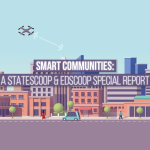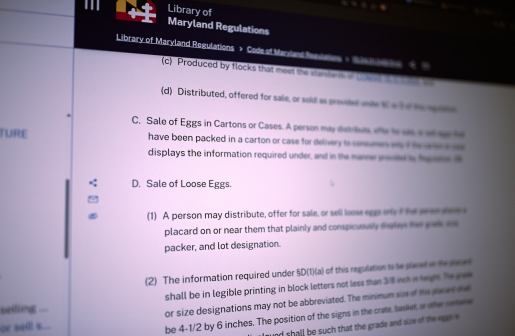How West Sacramento plans to become the smartest small city in America

In 2016, West Sacramento voters easily approved a 0.25 percent sales tax hike that was allocated to, among other things, enhancing internet access and “the use of smart technologies.” With the public on board to improve government services through new uses of technology, Democratic Mayor Christopher Cabaldon says it was an opportunity to partner with startups and entrepreneurs to test new ideas that would be hard to test in a larger urban area and also stay open to the idea that the city might find and solve some new problems that officials didn’t even know they had.
Now, he says he wants West Sacramento to be “the smartest small city in America.”
Several initiatives already are making West Sacramento’s suite of projects uncommonly well-rounded, innovative and ambitious for a city government — particularly for a municipality of just 50,000 people.
Cabaldon has been mayor for nearly 20 years, and he has extensive knowledge and experience in handling the region’s assets and challenges. He led a Sacramento-based education nonprofit before spending a decade with the California State Assembly in consulting and director roles and then working as legislative director for the University of California Students Association.
West Sacramento’s process is not really about the technology, Cabaldon tells StateScoop, echoing a common refrain from smart cities advocate. It’s about improving service to the public. It means repairing roads and trails, reducing homelessness, creating new educational and career paths for residents, and — ultimately — building a place where people can and want to live. West Sacramento has grown quickly under Cabaldon, and he says he wants people to stick around.
I read somewhere that you want to make West Sacramento one of the smartest cities in America. What does that mean to you?
Yeah, so it’s kind of describing a suite of things that we’re doing as an effort to make West Sacramento, I should say, the smartest small city in America.
In addition to the capital-S, capital-C smart city work that’s aligned with work that’s going on in cities around the world, it also includes our signature West Sacramento Home Run initiative, which is actually about making West Sacramento and our residents smarter and smarter and smarter, more talented, more capable, more employable, more adaptable and resilient for the changing nature of work and careers in our community. It’s work we’re doing with an integrated preschool, paid internship college savings account, free community college, digital badges and other efforts that are about increasing education and talent in the city.
And what about the capital-S, capital-C smart city work?
On the larger smart city work, I think we put our toe in this in the smart city stream a couple of years back, then our whole foot, and then our knee, and now we’re now diving all the way in. We were a Code for America city, and I think at the time, one of the smallest ever, if not the smallest ever, invited to join that cohort. We, along with the cities of San Francisco and San Leandro, California, created the Startup in Residence program, where we incubate startups in the civic technology space inside City Hall so that they have the opportunity to really design for real reuse cases and learn from the actual processes on the ground. We have a lot of success in using that program, both to help launch some great startups, but also to infect our own culture inside City Hall with a lot of that lean and agile approaches to solutions development as well.
So we’ve been engaged in efforts like that, and those have caused us to join networks of other cities that have given us insights into what’s possible around the whole world of sensing and predictive analytics and bigger data and Internet of Things and other components of this smarter smart city agenda, frankly, a lot of which has felt out of reach because we’re just not a large city — we’re not a major market player. So if you develop a new sensor, a new technology, we’re not necessarily the place that you’re looking to to develop in order to get your product ready for the whole world. You want to go to Dubai or Chicago instead.
Particularly given your comprehensive approach to this, have there been other challenges in terms of your size?
In a Boston or a Chicago or San Francisco, the mayor launches a whole new office of innovation full of folks who’ve had experience in the startup and entrepreneurship world who are fluent in artificial intelligence or blockchain or other emerging technologies. And in a medium-size or smaller city you don’t have those degrees of freedom to create a whole new office to help to lead and shepherd and connect the incumbent streams of city government to that work. So that’s an ongoing challenge — we don’t change our IT and data and analytics staff that often, and therefore we’re not constantly recruiting from that world, and we can’t mount an office that’s writing our own apps, for example, in that way.
It’s not just about deploying technologies. It’s also around how does a government deal simultaneously with the need to have a comprehensive strategy and to think through things. How are these networks all gonna work together of sensors and IoT or whatever, how is it all going to fit together, and how is it gonna connect with our existing systems and all that? So it’s important to have a comprehensive long-term integrated view of the system of smart city technologies and approaches. At the same time, it’s important to actually do things and to iterate and to test and to try. Government’s not very good at the latter and it’s really not very good at doing both simultaneously.
In the era that we’re in now, it’s very much about processes, more so than its about finding objects that are necessarily public-facing. That then implicates the traditional processes and procedures and procurements and everything else in a much more profound way and that definitely requires a change in the way that city management works and a way that we as mayors and city leader’s kind of curate the governance cultures inside the building.
It’s not a question of choosing between being experimental and iterative and working with entrepreneurs in your own city on an opportunistic basis or doing a comprehensive five-year plan. You have to do both at the same time and take some chances in both domains simultaneously.
Were you surprised at all to see support from voters for a sales tax increase that would go in part to investing in smart technologies?
No. Although that’s because we very intentionally were not proposing to citizens that we just do smart cities work for the sake of smart cities work. If we change the way we do procurement or if we change the material that were using for piping in the city, we don’t make a big deal out of it. We don’t herald it as some important thing that citizens need to care about — they just care about the services getting delivered.
Or, the alternative sometimes is the smart city vision becomes too fantastical, which either scares citizens that the entire world is changing and there’s gonna be a sensor in everything and your parking meter is gonna be airborne and everything — it’s just too much. And it doesn’t feel real because it isn’t, and it starts to then raise fears about privacy and Big Brother and all of that. It is often the case that either we’re not communicating at all about smart cities or we are over-communicating some big, long-term vision out of Dubai and not really communicating in terms about what it really means for the citizens.
So when we talked about it with our voters, it was making some investments in smart city innovations for the purposes of improving mobility — of advancing the work that we’re doing with AARP on age-friendliness in the city and making it more possible for folks as they age in our city to get around and to have gainful employment to make a difference in their community. And to help us reinvent the way that we do civic engagement and bring that out of the 18th century into today.
Earlier you mentioned the changing nature of work — how is West Sacramento adapting to that?
In my city already it is the case we have more jobs than people and we have an unemployment rate that is higher than average in our region. It always has been. And it’s improved, but it’s a stark contrast from what you would expect. The cause of it, really, is a pretty profound skills gap. The structure of existing jobs is requiring higher and higher levels of skills and what we know from both the impacts of globalization and trade is that for residents in my city to be able to be competitive — not just with the cities down the highway, which is what we’ve traditionally focused — but with the city or town in Ecuador or in Malaysia, we’ll only win in good jobs that can support a family to the extent that our skills levels are higher than they have been, and higher than they are in those places. Part of it is being prepared for simply the future of the competitiveness of work on a global scale that we’re preparing our residents for.
But just as profoundly on the technology and automation side, with whatever you think about the individual predictions, a large number of current jobs are going to be destroyed or fundamentally transformed with increasing automation and artificial intelligence and so we’ve got to provide opportunities and options for residents to switch into other sectors, or to be the bosses and the designers of the machines and not their slaves, so automation and AI are a certain component of that.
And then a third element of it is the changing nature of the jobs themselves and a large majority of the new jobs that have been created in the U.S. economy have been in the gig economy and adjacent sectors, not in traditional jobs. So we can expect that trend and offshoots and evolutions of that trend to continue. And so simply training folks for a job that you will have with one company over a lifetime where you have a boss and all of that is not enough.
Given your background in education, do you think there is there anything that either K-12 or higher education could be doing differently to adapt to this evolving workforce?
Yeah, I think there’s a set of things all of us have to be doing differently. We have traditionally thought of workforce preparation as a one-time thing or a Band-Aid thing. You’re supposed to go to K-12, get your basic education, and then our expectation is that you’re gonna go to college when you’re 18 or so, get all the skills and knowledge and information that you need and then you go work somewhere for the rest of your life.
The college or university you’re going to go to, at least in California, it’s highly likely it’s going to be a public institution, it will be taxpayer-subsidized, it’s going to have a very fixed program and what have you. And if you want to get additional learning after that, it’s probably because you were retired and you saw an interesting program on PBS about Tuscany and so you’re gonna go take a lifelong learning class. That’s how we’ve conceived of this, and none of that works anymore. And none of that certainly works as a one-size-fits-all model or a model that is monopolized solely by the existing systems of higher education or workforce development. So, yes, both workforce systems and higher ed have to change in terms of providing much more fine-grained validated markers of skills and competencies and accomplishments than solely the bachelor’s degree and even with a bachelors degree folks increasingly are gonna need micro-credentials of what they actually know and can do that are portable and that an employee or an employer or entrepreneur can match up in ways that don’t necessarily sync with what our traditional view of a bachelors degree is. It is essential that colleges or universities start to essentially unbundle what the package of what they are offering to give folks over their whole lives the ability to get the skills and competencies and then contextualize those and ladder those up so folks can have careers with lots of different options in them in ways we haven’t in the past.
But it is also true for the workforce development system where traditionally we focused on workforce development as an emergency room. The system’s not designed for the kind of economy in which most of our residents are gonna change jobs eight or nine times and may change careers three or four times. The workforce system has not been well tooled-up for that, so it also has to change.
I think the final part of that equation is that the actors, the players in the talent and career world are already burgeoning well beyond the traditional system of higher education or the workforce system. And so we are seeing many many more coding boot camps or the massively online open courses, but many, many, many, many more folks are entering the space with opportunities and options for people of all ages to be able to learn, to get, to demonstrate, to validate actual skills and competencies that advance them through a progression of jobs and careers.
Ten years from now, what’s your ambition for West Sacramento?
The way we’ve described our Home Run is we are intending to become the best place to raise a family, the best place to grow up and the best place to find talent if you’re an employer or entrepreneur. Those are our three objectives.
And they’re also measurable. One of our challenges as an urban city today is folks say, “Well, I just don’t know if this is a place I want to raise a child.” So this is a measurable phenomenon from polling, from elections, from other indicators, and so we’re going to be tracking that. If the proportion of folks that are feeling confident that this is a city which I am excited to raise a family in is increasing then we know over the next 10 years that we will have succeeded.
Same thing on the workforce side. We’re very good at attracting companies, we’re very good at getting startups to get going in the city, but our biggest challenge has been them saying “Luckily we can drop from outside the city for employees cause you just don’t have the kinds of skills that we need” and that’s also measurable over time and we expect to make a huge dent in that that will increase the number of high quality jobs and entrepreneurial opportunities in the city over time as well.
And then we wanna be the best place to grow up. Ultimately so that young people and not-as-young people see this as a lot of opportunities as a place to stay, as a place where you make your future.
This interview was edited for readability and concision.

This story was featured in StateScoop Special Report: Smart Communities (2018)






